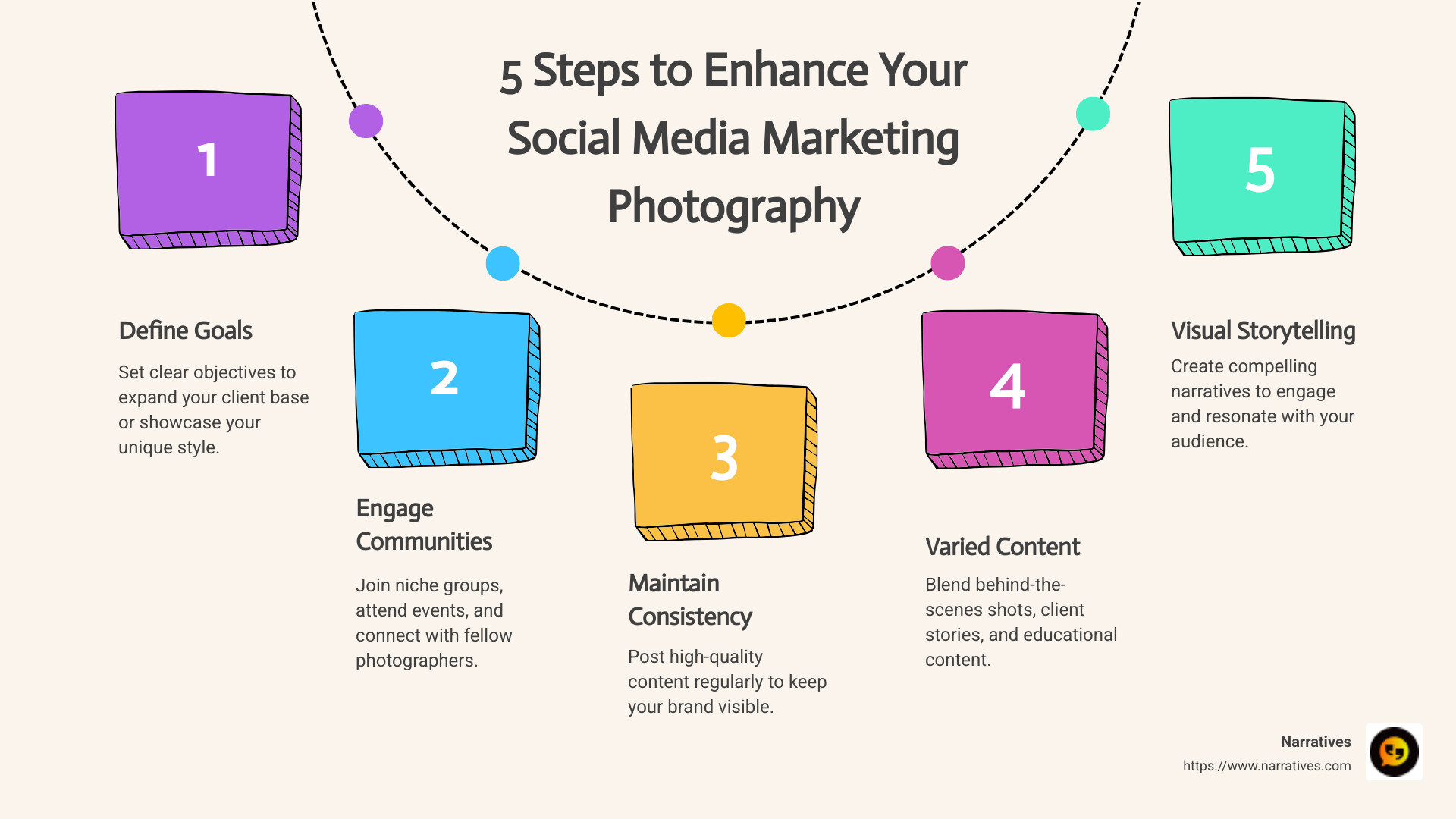Focus on Growth: Social Media Strategies for Photographers

Social media marketing photography is more than just posting beautiful images online. It's a powerful tool that can propel your photography business forward, bringing in new clients and growing your brand. For photographers aiming to expand their reach and storytelling capabilities, mastering social media marketing is essential.
Key points to quick-start your strategy:
- Define clear goals: Know what you want to achieve, whether it's expanding your client base or showcasing your unique style.
- Engage with communities: Join niche-specific groups, attend events, and connect with fellow photographers.
- Consistency is key: Regular, high-quality posts help keep your brand visible and recognizable.
- Use varied content: Blend behind-the-scenes shots, client stories, and educational content to maintain engagement.
A well-thought-out social media presence helps photographers not just survive but thrive in a competitive marketplace. As our digital lives expand, so does the importance of creating compelling visual narratives that resonate with audiences and communities.

Social media marketing photography terms to know:
- social media marketing for photographers
- social media content creation company
- social media branding company
Why Social Media Marketing Photography Matters
Social media marketing photography isn't just an option—it's a necessity. It plays a crucial role in boosting your online exposure, crafting your brand's story, and driving engagement.
Maximizing Online Exposure
Think of social media as your personal gallery, but with a global audience. Unlike a physical gallery that limits you to local visitors, social media offers a platform where millions can view your work. This exposure is invaluable. According to research, posts with images generate significantly higher engagement than text-only posts. 
Being active on social media means your work isn't just seen—it's shared. This sharing can lead to more followers and potential clients. The more people see your work, the more opportunities you have to connect with those who might need your services.
Crafting Your Brand's Story
Every photographer has a unique story to tell, and social media is the perfect stage to share it. Your images can communicate your values, style, and vision. This is known as brand storytelling. When done right, it creates a deeper connection with your audience.
For example, using behind-the-scenes photos can show your creative process, while client testimonials can highlight your professionalism and skill. These elements help build a narrative that resonates with viewers, making your brand memorable.
Driving Engagement
Engagement is more than just likes and comments; it's about building relationships. Social media allows you to interact directly with your audience, creating a two-way conversation. This interaction fosters a sense of community and loyalty.
Responding to comments, asking questions, and sharing user-generated content are simple ways to improve engagement. When your audience feels valued, they're more likely to stay connected and spread the word about your work.
In conclusion, social media marketing photography is about more than just exposure. It's about telling your story and engaging with your audience in meaningful ways. As you venture into this digital landscape, each post is an opportunity to connect, inspire, and grow your photography business.
Building a Client-Centric Social Media Strategy
Creating a client-centric social media strategy is essential for photographers aiming to thrive in the digital world. This approach focuses on understanding and engaging with your audience, targeting the right people, and selecting the right niche for your photography business.
Client Engagement
Engagement is the heartbeat of social media. For photographers, it means more than just getting likes or comments. It's about building genuine relationships with your audience.
Be Responsive: Answer questions, reply to comments, and thank people for their feedback. This interaction makes your followers feel valued and appreciated.
Share Behind-the-Scenes Content: Let your audience in on your creative process. Share stories about the challenges and joys of capturing that perfect shot. This transparency builds trust and makes your brand relatable.
Use Interactive Features: Polls, Q&A sessions, and live videos are great tools to engage your audience. They encourage participation and make your followers feel like they're part of your journey.
Audience Targeting
Knowing your audience is crucial. Without a clear understanding of who they are, your efforts might not hit the mark.
Identify Your Ideal Client: Are they newlyweds, corporate clients, or pet owners? Understanding their demographics and interests helps tailor your content to meet their needs.
Use Analytics Tools: Platforms like Instagram and Facebook offer insights into your audience's behavior. Use this data to refine your strategy and focus on what works.
Create Content for Your Audience: Tailor your posts to resonate with your audience's preferences. If your followers love vibrant landscapes, give them more of that. This targeted approach ensures higher engagement and satisfaction.
Niche Selection
Choosing the right niche is a game-changer for photographers. It helps you stand out in a crowded market and attract clients who value your specific expertise.
Define Your Niche: Decide if you want to specialize in wedding photography, portraits, landscapes, or something else. A clear niche makes it easier for potential clients to find you.
Consistency is Key: Once you choose a niche, stick to it. Consistent style and quality build a recognizable brand. As noted, a niche marketing appeal can attract more clients who know what to expect from you.
Balance with Variety: While focusing on a niche, don't shy away from showing versatility. Use a social media content calendar to assign different days for different photography categories. This keeps your feed fresh and engaging without losing focus.
Building a client-centric social media strategy involves more than just posting pretty pictures. It's about engaging with your audience, understanding their needs, and positioning yourself as an expert in your chosen niche. By doing so, you create a community around your brand, ensuring long-term success in social media marketing photography.
Social Media Marketing Photography: Choosing the Right Platforms
Choosing the right social media platforms is crucial for photographers looking to maximize their reach and engagement. Each platform offers unique opportunities and caters to different audiences. Let's explore the most effective platforms for social media marketing photography.
Instagram is a powerhouse for photographers. It's a visual-first platform, making it ideal for showcasing your work.
Visual Storytelling: Instagram allows you to tell stories through your images. Use the carousel feature to show a series of photos that narrate a story or capture an event.
Hashtags and Geotags: Leverage hashtags and geotags to increase your visibility. They help categorize your work and make it findable to users interested in specific themes or locations.
Engagement Tools: Use Instagram Stories, Reels, and IGTV to engage your audience with diverse content. These features allow you to share behind-the-scenes moments, tips, and more.
Though not as visually focused as Instagram, Facebook remains a vital platform for building a community and engaging with a broader audience.
Community Building: Join or create photography groups to connect with other photographers and potential clients. These groups are great for sharing tips, asking questions, and showcasing your work.
Event Promotion: Use Facebook Events to promote photography workshops, exhibitions, or special shoots. This feature can help you reach a local audience effectively.
Targeted Ads: Facebook's advertising tools allow you to target specific demographics, making it easier to reach potential clients interested in your photography niche.
Pinterest is a goldmine for photographers, especially those whose work inspires creativity and ideas.
Evergreen Content: Pins on Pinterest have a long lifespan. Create content that remains relevant over time to keep attracting views and repins.
Inspirational Boards: Curate boards that reflect your photography style and niche. For example, if you're a wedding photographer, create boards for wedding themes, dress ideas, and venue inspirations.
Traffic Generation: Pinterest can drive significant traffic to your website or portfolio. Ensure your pins link back to your site to convert viewers into clients.
LinkedIn might not be the first platform you think of for photography, but it's invaluable for those specializing in corporate or event photography.
Professional Networking: Connect with businesses and professionals who might need your services for corporate events or headshots.
Content Sharing: Share articles or posts about photography trends, tips, and your professional journey. This establishes you as an expert in your field.
Showcase Your Portfolio: Use LinkedIn to highlight your best work and client testimonials. A professional portfolio can attract potential corporate clients.
Choosing the right platforms for social media marketing photography depends on your niche and target audience. By understanding each platform's strengths and tailoring your strategy accordingly, you can effectively promote your photography business and reach your ideal clients.
Creating Compelling Content
Creating compelling content is the heart of social media marketing photography. It's not just about posting pretty pictures; it's about telling stories, maintaining consistency, and ensuring high quality. Let's explore how you can make your content stand out.
Visual Storytelling
Visual storytelling is a powerful tool for photographers. Each photo should tell a story or evoke an emotion. Think about what you want to convey through your images. Is it the joy of a wedding day, the serenity of a landscape, or the energy of a busy city street?
Series and Themes: Consider using a series of photos to tell a more comprehensive story. Instagram's carousel feature is perfect for this. You can show different stages of an event or different aspects of a subject.
Behind-the-Scenes: Share the story behind the shot. This could be the challenges you faced during the shoot or the inspiration behind the series. It adds depth and makes your content more relatable.
High-Quality Images
Quality matters. In a sea of images, high-quality photos will set you apart. They convey professionalism and attention to detail.
Technical Skills: Ensure your photos are well-composed, properly exposed, and sharply focused. These are the basics of a great photo.
Editing: Consistent editing styles help in maintaining a cohesive look across your social media. Decide on specific editing techniques and color schemes that reflect your artistic vision.
Professional Equipment: While you don't need the most expensive gear, investing in a good camera and lenses can make a significant difference in the quality of your images.
Consistency
Consistency is key in social media marketing photography. It builds trust and recognition among your audience.
Posting Schedule: Develop a content calendar. Decide how often you'll post and stick to that schedule. This helps in keeping your audience engaged and expecting your content.
Visual Style: Maintain a consistent visual style across all your platforms. This includes your color palette, composition style, and even the mood of your images.
Brand Voice: Your captions and interactions should reflect your brand's voice. Whether it's friendly, humorous, or professional, consistency in tone helps in building a strong brand identity.
By focusing on visual storytelling, ensuring high-quality images, and maintaining consistency, you'll create compelling content that resonates with your audience and improves your social media marketing photography efforts.
Next, we'll explore how leveraging hashtags and trends can further boost your online presence.
Social Media Marketing Photography: Leveraging Hashtags and Trends
In social media marketing photography, hashtags and trends are your secret weapons. They can boost your visibility and help you connect with a larger audience. Here's how to use them effectively.
The Power of Hashtags
Hashtags are like signposts on social media. They guide users to content they're interested in. For photographers, this means your work can reach people who are specifically looking for your style or niche.
Popular vs. Niche Hashtags: Use a mix of both. Popular hashtags like #photography or #weddingphotography can get your work seen by a broader audience. However, niche hashtags such as #urbanlandscape or #vintageportraits help you reach a more targeted group who are genuinely interested in what you offer.
Location-Specific Hashtags: If you're a local photographer, include hashtags related to your area, like #NYCphotographer or #LondonWeddings. This attracts clients looking for local talent.
Limit Your Hashtags: While it might be tempting to use a ton of hashtags, it's best to stick to three to five. This keeps your posts from looking cluttered and aligns with most social media algorithms.
Geotags: Pinpoint Your Audience
Geotagging is another powerful tool. By tagging your location, you make it easier for local clients to find you.
Local Visibility: Geotags put your photos on the map, literally. When users search for images from a specific location, your tagged photos can appear in their search results.
Community Engagement: Use geotags to engage with your local community. Comment on and like photos from other users in the same area to build connections.
Riding the Wave of Trending Topics
Trending topics can give your content a quick boost. They are what people are currently talking about, and joining the conversation can increase your visibility.
Stay Updated: Keep an eye on current events, popular culture, and industry trends. Platforms like Twitter and Instagram often highlight trending topics.
Relevant Content: When you find a trend that aligns with your work, create content around it. For example, during a major event like the Olympics, sports photographers can share relevant images with trending hashtags.
Participate in Challenges: Many social media platforms have photography challenges. Participating in these can get your work featured and in front of new eyes.
By strategically using hashtags, geotags, and trending topics, you can significantly improve your social media marketing photography efforts. These tools not only increase your reach but also connect you with potential clients who are genuinely interested in your work.
Next, we'll dig into how to engage effectively with your audience to build lasting relationships.
Engaging with Your Audience
Engaging with your audience is crucial in social media marketing photography. It's not just about posting pretty pictures; it's about building a community, fostering interaction, and maintaining authenticity. Let's explore how you can achieve this.
Community Building
Building a community around your photography brand creates a loyal audience that supports and promotes your work.
Be a Friendly Neighbor: Participate in local groups and discussions. Share valuable information and be seen as a helpful community member, not just a business. This can help you gain trust and recognition.
Create a Safe Space: Encourage your followers to share their thoughts and experiences. This can be through comments, polls, or direct messages. Make them feel heard and valued.
Support Local Causes: Engage with local events or causes. Share photos from community events or collaborate with local businesses. This not only boosts your visibility but also shows your commitment to the community.
Interaction
Interacting with your audience keeps them engaged and encourages them to interact with your content.
Respond to Comments: Always reply to comments on your posts. A simple "thank you" or a thoughtful response can go a long way in building relationships.
Ask Questions: Use your captions to ask questions or start conversations. This invites your audience to engage and share their opinions.
Host Live Sessions: Go live on platforms like Instagram or Facebook to discuss your photography process, share tips, or just chat with your audience. This real-time interaction can strengthen your connection with followers.
Authenticity
Being authentic helps you stand out in the crowded social media landscape.
Share Your Story: Let your audience in on your journey. Share behind-the-scenes content, personal anecdotes, or the story behind your photos. This makes you relatable and builds a deeper connection.
Be Genuine: Avoid overly polished content. Instead, focus on being genuine and true to your style. Your audience will appreciate the authenticity and be more likely to engage with your work.
Show Empathy: During challenging times, like natural disasters or community struggles, offer support and resources. This shows you care about your community beyond your business interests.
By focusing on community building, interaction, and authenticity, you can create a meaningful and engaged audience. This not only improves your social media marketing photography efforts but also fosters lasting relationships with your followers.
Next, we'll tackle some frequently asked questions about social media marketing for photographers.
Frequently Asked Questions about Social Media Marketing Photography
How can photographers effectively use social media?
Photographers can effectively use social media by focusing on visual storytelling and consistent engagement. Here are a few strategies:
Showcase Your Best Work: Always share high-quality images that reflect your unique style. Consistency in quality helps set expectations for your audience.
Tell a Story: Use captions to share the story behind your photos. This adds depth to your images and encourages followers to connect with your work on a personal level.
Engage Regularly: Interaction is key. Respond to comments and messages promptly, and engage with your followers' content to build a supportive community.
Use Features: Take advantage of platform-specific features like Instagram Stories or Facebook Live to share behind-the-scenes content and offer followers a glimpse into your creative process.
What are the best platforms for photography marketing?
The best platforms for social media marketing photography depend on your target audience and style. Here are some top choices:
Instagram: With its visual focus, Instagram is ideal for photographers. Use it to share your portfolio and connect with potential clients.
Facebook: Great for building a community and sharing a mix of content types, including photos, videos, and events.
Pinterest: Excellent for reaching audiences interested in inspiration and ideas. Pin your work to relevant boards to drive traffic to your website or portfolio.
LinkedIn: While not traditionally visual, LinkedIn can be useful for networking with other professionals and finding corporate photography opportunities.
How do hashtags help in social media marketing photography?
Hashtags are powerful tools in social media marketing photography for expanding your reach:
Increase Visibility: Hashtags categorize your content, making it findable to users searching for those specific tags.
Target Niche Audiences: Use niche-specific hashtags to reach your ideal audience. For example, #weddingphotography targets those interested in wedding-related content.
Join Conversations: Trending hashtags allow you to join larger conversations and increase the chances of your work being seen by a broader audience.
Improve Local Reach: Geotags and location-specific hashtags can attract local clients looking for photographers in your area.
By understanding how to use social media effectively, choosing the right platforms, and leveraging hashtags, photographers can significantly improve their online presence and grow their business.
Conclusion
In social media marketing photography, storytelling is the key to open uping growth and engagement. At Narratives, we believe in the power of storytelling to lift voices and create meaningful connections. This is especially true for non-profits and purpose-driven organizations that aim to inspire action and foster community.
Narratives specializes in helping non-profits share their impactful stories through high-quality, emotionally resonant multimedia content. By focusing on storytelling, these organizations can build trust and increase visibility. This approach not only showcases their mission but also highlights the real difference they make in the world.
For photographers, embracing storytelling on social media can transform your online presence. By sharing the stories behind your images, you create a personal connection with your audience. This connection is what turns casual viewers into loyal followers and clients.
Whether you're a photographer or a non-profit, the ability to tell your story effectively is crucial. By partnering with a digital storytelling expert like Narratives, you can ensure that your message is heard and felt.
Explore how our media network services can help you share your story and make an impact. Let's work together to lift your voice and inspire change.


